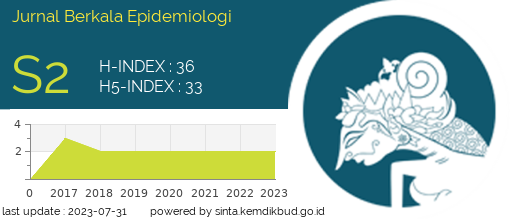CORRELATION BETWEEN ACCESS OF DRINKING WATER AND SANITATION WITH DIARRHEA INCIDENCE IN EAST JAVA
Downloads
Background: Diarrhea is still a major health problem in Indonesia. The Province of East Java ranks the second-highest number of diarrhea incidence after West Java, which reached 1,048,885 patients. The most dominant factors contributing to diarrheal diseases are water and family latrines. Purpose: This study aims to analyze the relationship between access to drinking water and proper sanitation with the incidence of diarrhea in East Java. Methods: This study was an observational study with a correlation study design. The population used was all people suffering from diarrheal diseases handled by each district in East Java Province in 2017. The method of sampling used aggregate data on the number of cases of diarrhea handled and the number of people with access to drinking water and proper sanitation per district/city in East Java province based on the East Java Health Profile 2017. The variables studied were the number of people who had access to drinking water (feasible), the number of people who had access to proper sanitation facilities (healthy latrines), and the number of diarrhea cases handled in East Java Province, with analysis techniques in the form of pearson correlation. Results: This study showed that there was a relationship between residents who had access to inadequate drinking water (p = 0.00) which had a strong relationship of 0.48 (strong enough) and there was also a relationship between residents with inadequate access to sanitation facilities (not have healthy latrines) (p = 0.00) which had a strong relationship of 0.53 (strong enough). Conclusion: There is a relationship between access to drinking water and sanitation that is not feasible with the incidence of diarrhea found in East Java.
Aini, N., Raharjo, M., & Budiyono. (2016). Hubungan kualitas air minum dengan kejadian diare pada balita di wilayah kerja Puskesmas Banyuasin Kecamatan Loano. Jurnal Kesehatan Masyarakat (e-Journal), 4(1), 399–406.
Duwila, F., Trijoko, Lanang, H., & Astorina, N. (2018). Pemetaan sanitasi dasar dengan penyakit diare pada masyarakat desa pesisir Kecamatan Mangoli Timur Kabupaten Kepulauan Sula Provinsi Maluku Utara tahun 2018. Jurnal Kesehatan Masyarakat (e-Journal), 6(6), 119–127.
East Java Provincial Health Office. (2018). East Java province health profile 2017. Surabaya: East Java Provincial Health Office.
Evayanti, N. K. E., Purna, I. N., & Aryana, I. K. (2014). Faktor-faktor yang berhubungan dengan kejadian diare pada balita yang berobat ke Badan Rumah Sakit Umum Tabanan. Jurnal Kesehatan Lingkungan, 4(2), 134–139.
Fatmawati, Arbianingsih, & Musdalifah. (2015). Faktor yang mempengaruhi kejadian diare anak usia 3-6 tahun di TK Raudhatul Athfal Alauddin Makassar. Journal of Islamic Nursing, 1(1), 21–32.
Langit, L. S. (2016). Hubungan kondisi sanitasi dasar rumah dengan kejadian diare pada balita di wilayah kerja Puskesmas Rembang 2. Jurnal Kesehatan Masyarakat (e-Journal), 4(2), 160–165.
Lestari, D. R. W., & Dyah, Y. (2017). Hubungan antara pengetahuan dan kebiasaan mencuci tangah pengasuh dengan kejadian diare pada balita. Journal of Health Education, 2(1), 39–46.
Meliyanti, F. (2016). Faktor-faktor yang berhubungan dengan kejadian diare pada balita. Jurnal Ilmu Kesehatan Aisyah, 1(2), 9–15.
Melvani, R. P., Zulkifli, H., & Faizal, M. (2019). Analisis faktor yang berhubungan dengan kejadian diare balita di Kelurahan Karyajaya Kota Palembang. JUMANTIK: Jurnal Ilmiah Penelitian Kesehatan, 4(1), 57–68. https://doi.org/10.30829/jumantik.v4i1.4052
Ministry of Health RI. (2015). Indonesia health profile 2014. Jakarta: Ministry of Health RI.
Ministry of Health RI. (2017). Indonesia health profile 2016. Jakarta: Ministry of Health RI.
Ministry of Health RI. (2018). Indonesia health profile 2017. Jakarta: Ministry of Health RI.
Nurfita, D. (2017). Faktor-faktor yang berhubungan dengan kejadian diare pada balita di Puskesmas Bulu Lor Kota Semarang. Kes Mas: Jurnal Kesehatan Masyarakat, 11(2), 149–154. https://doi.org/10.12928/kesmas.v11i2.7139
Nurpauji, S. V., Nurjazuli, & Yusniar. (2015). Hubungan jemis sumber air, kualitas bakteriologis air, personal hygiene dengan kejadian diare pada balita di wilayah kerja Puskesmas Lamper Tengah Semarang. Jurnal Kesehatan Masyarakat (e-Journal), 3(1), 569–578.
Oktariza, M., Suhartono, & Dharminto. (2018). Gambaran kondisi sanitasi lingkungan rumah dengan kejadian diare pada balita di wilayah kerja Puskesmas Buayan Kabupaten Kebumen. Jurnal Kesehatan Masyarakat (e-Journal), 6(4), 476–484.
Rahmadian, S., Ketaren, O., & Sirait, A. (2017). Faktor-faktor yang berhubungan dengan kejadian diare di Puskesmas Perwatan Ngkeran Kabupaten Aceh Tenggara pada tahun 2017. Jurnal Ilmiah Simantek, 1(3), 64–79.
Rohmah, N., & Syahrul, F. (2017). Hubungan kebiasaan cuci tangan dan penggunaan jamban sehat dengan kejadian diare balita. Jurnal Berkala Epidemiologi, 5(1), 95–106. https://doi.org/10.20473/jbe.v5i1
Rospita, Tahlil, T., & Mulyadi. (2017). Upaya pencegahan diare pada keluarga dengan balita berdasarkan pendekatan planned behaviour theory. Jurnal Ilmu Keperawatan, 5(1), 50–59.
Sari, D. M. (2016). Hubungan sumber air minum terhadap kejadian diare pada keluarga. TRIK: Tunas-Tunas Riset Kesehatan, 6(4), 194–198.
Sukardi, Yusran, S., & Tina, L. (2016). Faktor-faktor yang berhubungan dengan kejadian diare pada balita umur 6-59 bulan di wilayah kerja Puskesmas Poasia tahun 2016. Jurnal Ilmiah Mahasiswa Kesehatan Masyarakat, 3(1), 1–12. https://doi.org/https://doi.org/10.3929/ethz-b-000238666
- Every manuscript submitted to must observe the policy and terms set by the Jurnal Berkala Epidemiologi
- Publication rights to manuscript content published by the Jurnal Berkala Epidemiologi is owned by the journal with the consent and approval of the author(s) concerned. (download copyright agreement)
- Complete texts of electronically published manuscripts can be accessed free of charge if used for educational and research purposes according to copyright regulations.

JBE by Universitas Airlangga is licensed under a Creative Commons Attribution-ShareAlike 4.0 International License.























